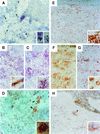Expression of inducible nitric oxide synthase in skin lesions of patients with american cutaneous leishmaniasis
- PMID: 12117977
- PMCID: PMC128200
- DOI: 10.1128/IAI.70.8.4638-4642.2002
Expression of inducible nitric oxide synthase in skin lesions of patients with american cutaneous leishmaniasis
Abstract
Cytokine-inducible (or type 2) nitric oxide synthase (iNOS) is indispensable for the resolution of Leishmania major or Leishmania donovani infections in mice. In contrast, little is known about the expression and function of iNOS in human leishmaniasis. Here, we show by immunohistological analysis of skin biopsies from Mexican patients with local (LCL) or diffuse (DCL) cutaneous leishmaniasis that the expression of iNOS was most prominent in LCL lesions with small numbers of parasites whereas lesions with a high parasite burden (LCL or DCL) contained considerably fewer iNOS-positive cells. This is the first study to suggest an antileishmanial function of iNOS in human Leishmania infections in vivo.
Figures

References
-
- Anstey, N. M., J. B. Weinberg, M. Y. Hassanali, E. D. Mwaikambo, D. Manyenga, M. A. Misukonis, D. R. Arnelle, D. Hollis, M. I. McDonald, and D. L. Granger. 1996. Nitric oxide in Tanzanian children with malaria: inverse relationship between malaria severity and nitric oxide production/nitric oxide synthase type 2 expression. J. Exp. Med. 184:557-567. - PMC - PubMed
-
- Bogdan, C. 2001. Nitric oxide and the immune response. Nat. Immunol. 2:907-916. - PubMed
-
- Bogdan, C., M. Röllinghoff, and A. Diefenbach. 2000. Reactive oxygen and reactive nitrogen intermediates in innate and specific immunity. Curr. Opin. Immunol. 12:64-76. - PubMed
Publication types
MeSH terms
Substances
LinkOut - more resources
Full Text Sources

